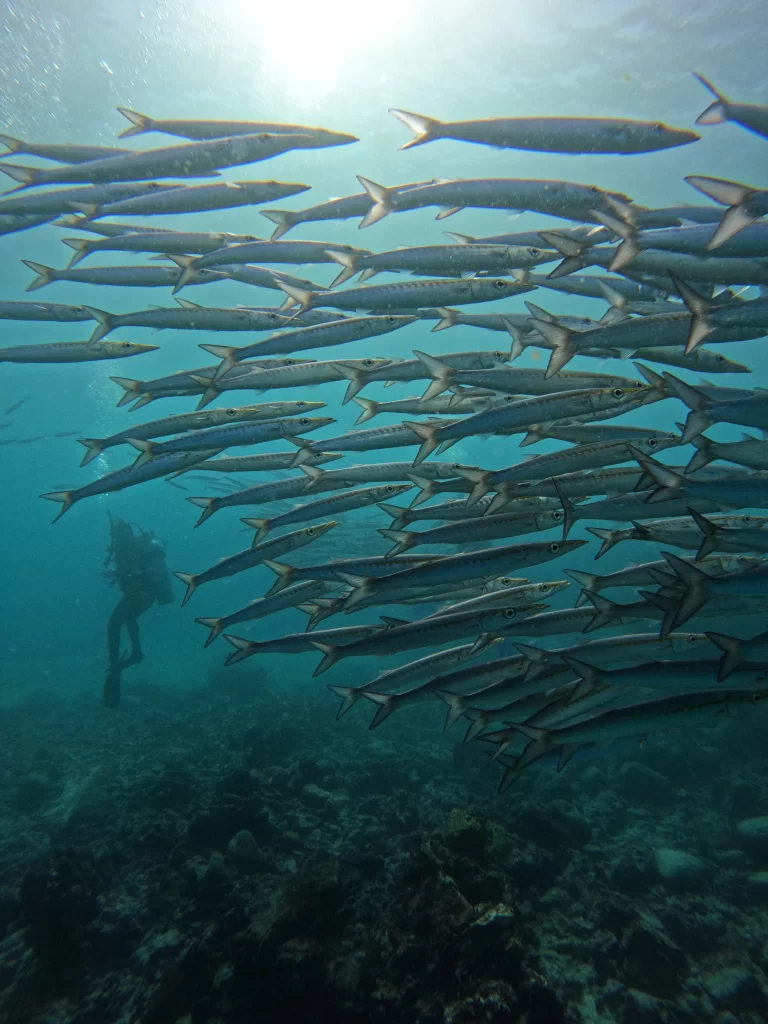The Galapagos Islands, located off the coast of Ecuador, are renowned for their natural beauty, diverse wildlife and dive sites. The archipelago is home to some of the world’s best dive spots, attracting divers from all around the globe. If you want to go diving in San Cristóbal, Galapagos Blue Evolution is the dive center for you.

Kicker Rock
Kicker Rock, also known as León Dormido is one of the most famous dive sites in the Galapagos. This rock formation towers up from the ocean floor where divers can explore the area around and in the channel between the two rocks. This dive site is home to a variety of marine animals such as hammerhead sharks, Galapagos sharks, blacktip sharks, whitetip reef sharks, large rays, sea lions, big schools of fish and more. If you’re really lucky you might even encounter whale sharks. Kicker Rock is truly a bucket list dive site for any diver visiting San Cristobal.
Read more about Kicker Rock
Tijeretas
Tijeretas is a popular dive site located on the coast of the island, and is known for its sea lion colony. Divers can expect to encounter a range of species, including sea turtles, stingrays, sea lions and sharks. The water here is relatively calm, making it an excellent site for beginners or those who prefer a more relaxed dive to a max depth of 10m/33ft. Heading outside off the bay the bottom gradually goes down in steps to 25m/82ft and connects to the open water. Here you will have a chance to encounter bullhead sharks, dolphins and eagle rays.

Roca Ballena
A little less know than Kicker Rock, Roca Ballena is a dive site for divers looking to see some of Galapagos’ most iconic species. This site is known for its large schools of fish like tunas, barracudas, manta rays, sea turtles, hammerhead sharks (if you’re lucky) and other marine life. The rock itself rises up from the ocean floor out of the water resembling a whale coming up to the surface, providing an excellent backdrop for underwater photography.
Karahua
Karahua is a wreck dive located just outside of the port of Puerto Baquerizo Moreno. This 100m/330ft long ship that is around 120 years old. It’s not just part of the history of San Cristobal but it has also become part of the underwater environment. It lies on a maximum depth of 14m/46ft and is home to an abundance of marine life. Here you will especially find smaller animals including nudibranch, seahorses, octopuses, but also pufferfish and rays.
Punta Pitt
Punta Pitt, located on north of San Cristobal Island, is home to a lot of sea lions, rays and has an abundance of garden eels. It is a calm dive spots with a little reef and a small cave that shelters whitetip sharks.
When visiting Punta Pitt you will also go on land. This is one of the few places in the world where you can see three different species of boobies: red-footed, blue-footed and Nazca.
Isla Española
Isla Española, also known as Gardeners Bay is a wide site with a maximum depth of 14m/46ft. The dive site has a dark cave for which you will get a flashlight to explore. The site offers marine life such as golden rays, sea lions, marine iguanas and other unique species found only in the Galapagos. On land you might also encounter the amazing albatros.
Cueva de los Corales
Located on the western coast of San Cristobal Island, is another popular dive site that’s famous for its underwater caves. The maximum depth of the dive site is 34m/112ft. Divers can explore a series of interconnected lava tunnels and chambers, home to a wide range of marine creatures, including micro animals like seahorses, nudibranch as well as spiny lobsters, octopuses, steel ray and bullhead sharks.
Cueva de la Bahía
Also know as Bay Cave, this unique dive site is famous for schools of larger fish such as gruppers, barracudas and tuna. Here you will find a 24m/78ft long tunnel to explore that is also home to a variety of other marine life, including sea turtles, stingrays and colorful reef fish. This drift dive has a maximum depth of 25m/82ft
So no matter your skill or certification level, we offer top dive sites in the Galapagos that perfectly suit your experience and we gladly help out with any questions or requests when possible.
If you have any questions or inquires please feel free to reach out.

Galapagos Blue Evolution Dive Center
Avenida Charles Darwin and 12 de Febrero
Puerto Baquerizo Moreno – San Cristobal Island Galapagos Islands – Ecuador
Phone: +593 5 2 520176 / 5 3010264
Mobile: +593 985877122
